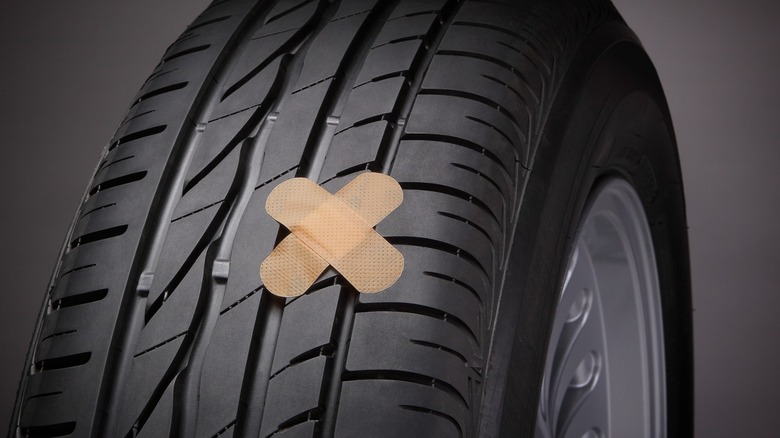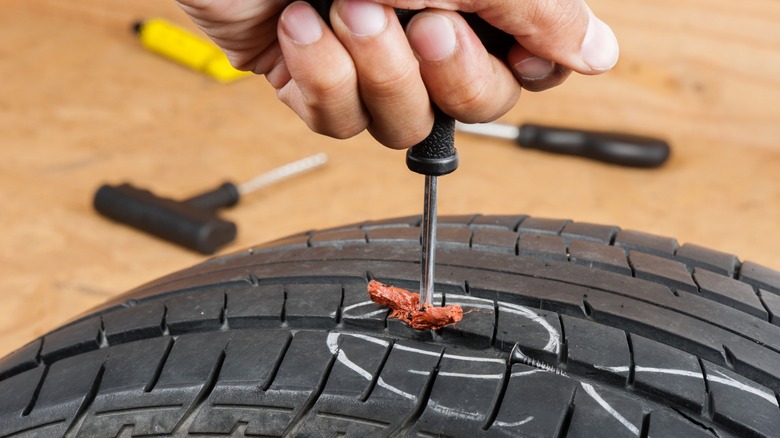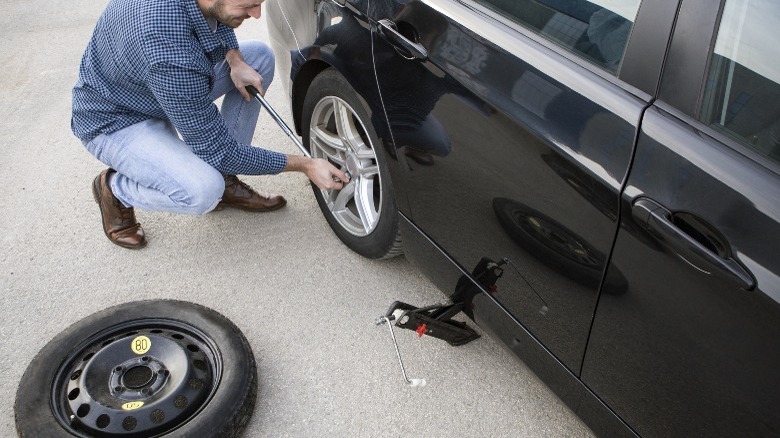How To Tell If That Hole In Your Tire Is Too Big To Fix
Tires can be expensive to replace — luckily, modern tires are quite hardy and can last through many years of use. They can also be fixed when they get punctured — provided the hole is reasonably sized and only affects the tire tread. While that sums up the general idea of all you need to know about tire holes, the nuances of this information may be unclear. To get a clearer picture, you must know a tire's rudimentary parts.
The tire tread is the part of the tire that makes contact with the road. It's the side most likely to get punctured if you run over something sharp, like a nail. The nearest part to the tread are the sidewalls. The outer sidewall is often where tire brands put their names, logos, and other information about the tire you might want to know as the user.
If your tire sidewall ever gets damaged, the NHTSA has stated that the tire is no longer fit for the road. It doesn't matter how small or large the hole is. Damage to the sidewall will compromise your safety and potentially that of others. It needs to be replaced.
This rule, however, doesn't apply to the tire tread, which can be fixed through plugging, patching, or a combination of the two — as long as the hole isn't too big.
What hole size is considered too large to fix?
The Department of Transportation has set guidelines following the recommendations of industry experts for what sizes of holes can and should be fixed. The U.S. Tire Manufacturers Association recommends that the puncture should never be more than a quarter of an inch in diameter (the quarter-inch rule). Tire injuries that can be fixed only affect the tread and stay between the outside shoulder grooves.
While plugging the hole or patching alone could help keep the tire going a while longer, these are not necessarily long term solutions. The best and recommended way to fix a tire is using the combination of a plug to fill the hole and a patch to seal it. But before doing that, the tire must be dismounted from the vehicle and inspected for further damage — no tire repairs should be done while the tire is still attached to the car.
Also, tire repairs cannot overlap, no matter what. If your tires have sustained damage in areas that meet, that tire must be disposed of. It doesn't matter if the injuries both meet the quarter-inch rule requirements; the tires are now deemed irreversibly unsafe.
Ignoring this procedure can be a primary cause of tire failure, a dangerous situation that may threaten your life. Also, when you're using a patched tire, try to inspect the tire pressure as often as you can to ensure the repair is holding up.
What do you do when you discover a hole in your tire?
You'll mostly discover a hole in your tire when your car is already parked. That's because the majority of tire injuries are small and may even still have the object that caused it lodged inside. This means the air will seep slowly; sometimes, you may not see any noticeable difference until several hours after the incident. However, if you notice odd vibrations coming from your tire while driving, stop immediately and inspect your tires for damage.
If you can find the hole, spray a little soapy water on it to see how much air is leaking out. If it bubbles rapidly, then you might need to change to a spare, but if there are little to no bubbles, you can take your car and drive to the nearest service center to get it checked out. This will work regardless of whether the object that caused the hole is still in it or not.
While we don't recommend fixing a tire yourself, you can check if it's time to repair or replace it by measuring the hole. Use a ruler or tape measure to see how large the diameter of the hole is. If it passes a quarter of an inch, it's time to buy a new one. Additionally, you might need to swap out all the tires when replacing the damaged one because it doesn't have the same level of wear, and the tread patterns might be different and weaken your car's frame.


